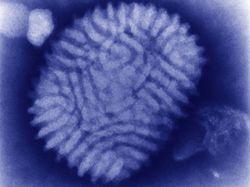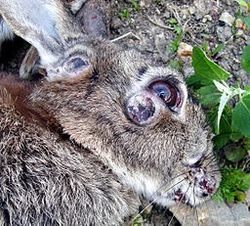Viruses as Pest Control: the coevolution of the Myxoma virus and its long-eared hosts
By Ilana Richter
Background
European colonists introduced rabbits to Australia at the end of the 1700s. European rabbits (Otyctolagus cuniculus) are native to southern Europe and northern Africa, but is considered an invasive pest species around the world. The rabbit population in Australia grew exponentially due to the lack of natural predators and warm climate that enabled year-round breeding. Australia was home to an estimated 10 billion rabbits by the 1900s. The Australian rabbit population caused widespread vegetation depletion, leading to soil erosion. The rabbits caused massive destruction of crops and pastures for livestock, resulting in a significant loss of agricultural productivity and harming the economy. Rabbits competed for resources with native herbivores, and themselves became food for the increasing population of native predators. These factors heavily contributed to the decline of native Australian herbivore populations. Australian farmers attempted to use various chemical pesticides, but those also proved detrimental to the ecosystem. In the 1950s, scientists proposed using the recently-discovered Myxoma virus to curb the rabbit population. This experiment in biological warfare ultimately failed to eliminate the rabbit infestation, but became an important experiment on the coevolution of a pathogen and its host.
Myxoma virus
The Myxoma virus is a poxvirus that lives commensally inside lagomorphs in South America and California. The virus is vectored by mosquitoes and fleas, but it can also be spread through direct contact with an infected animal.Myxoma virions are enveloped and rectangular. Like many poxviruses, they contain a bioconcave core. Myxoma has a non-segemented genome consisting of a single molecule of linear double-stranded DNA. Virons replicate within the cytoplasm of the host cell and reproduce by forming buds out of the host cell's membrane. The Myxoma virus infects fibroblasts, lymphocytes, and mucosal cells.
Pathology
The Myxoma virus produces extracellular proteins that specifically suppress or evade a rabbit’s immune response. Most lagomorphs are susceptible to the virus, but the virus is easily targeted by the immune systems of other species. The reservoir hosts of the virus (American rabbits) do not usually exhibit symptoms, except for occasional benign skin tumors. However, infected European rabbits contract the deadly disease myxomatosis. An effect of this severe immunosuppression is opportunistic infection by gram-negative bacteria. This disease manifests as development of lesions and tumors, fever, swelling, hemorrhage, respiratory malfunction, blindness, and death.
Experimental use in Australia
I have the last two sections written out in a google doc- just fixing the citations before I upload.
On coevolution
References
"Environmental Damage caused by Rabbits" (PDF). Archived from the original (PDF) on 18 December 2012. Retrieved 29 October 2014.
https://web.archive.org/web/20111125204128/http://www.csiro.au/science/Myxomatosis-History
http://www.abc.net.au/science/articles/2009/04/08/2538860.htm
https://www.theatlantic.com/science/archive/2017/08/rabbit-virus-arms-race/536796/
https://www.the-scientist.com/multimedia/infographic-evolving-virulence-30813
Authored for BIOL 238 Microbiology, taught by Joan Slonczewski, 2018, Kenyon College.



